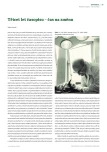Neglected cause of anisocoria – unilateral mydriasis
Authors:
M. Bílská 1,2; R. Škulec 1,3,4,5; D. Ospalík 6; B. Koulová 1; X. Waicová 1,2; V. Černý 1,5,7,8
Authors‘ workplace:
Klinika anesteziologie, perioperační a intenzivní medicíny, Univerzita J. E. Purkyně v Ústí nad Labem, Masarykova, nemocnice v Ústí nad Labem
1; Zdravotnická záchranná služba Ústeckého kraje, Ústí nad Labem
2; Zdravotnická záchranná služba Středočeského kraje, Kladno
3; Klinika anesteziologie, resuscitace a intenzivní medicíny, Univerzita Karlova, Lékařská fakulta v Hradci Králové, Fakultní nemocnice Hradec Králové
4; Fakulta zdravotnických studií, Univerzita J. E. Purkyně v Ústí nad Labem
5; Neurologické oddělení, Masarykova nemocnice v Ústí nad Labem
6; Centrum pro výzkum a vývoj, Fakultní nemocnice Hradec Králové
7; Department of Anesthesia, Pain Management and Perioperative Medicine, Dalhousie University, Halifax, Canada
8
Published in:
Anest. intenziv. Med., 31, 2020, č. 3, s. 124-126
Category:
Case Reports
Overview
Sudden anisocoria is an emerging neurological symptom. However, some causes are transient and benign. The authors present two cases of unilateral mydriasis, which evolved as an adverse local effect of nebulization treatment with ipratropium. Due to the frequency of administration of ipratropium in emergency and intensive care medicine, this may be a common but rarely noted complication. Consistent clinical neurological examination and comprehensive consideration of patient treatment can be helpful to avoid further unnecessary burdensome examinations.
Keywords:
anisocoria – inhalation administration – ipratropium
Sources
1. Patel R, Davis C, Sivaswamy L. Anisocoria – Not Always Cause for Alarm. J Pediatr. 2014; 164(6): 1497.
2. Stevenson A, Yoganathan K, Fox J, Shackleton D. Challenging case of unilateral mydriasis. Emerg Med J. 2019; 36(4): 201–218.
3. Hallett M, Cogan DG. Episodic Unilateral Mydriasis in Otherwise Normal Patients. Arch Ophthalmol. 1970; 84(2): 130–136.
4. Gross JR, McClelland CM, Lee MS. An approach to anisocoria. Curr Opin Ophthalmol. 2016; 27(6): 486–492.
5. Staňková Y, Skřičková J, Potrepčiaková S. Léčba akutní exacerbace chronické obstrukční plicní nemoci za hospitalizace a na lůžku intenzivní péče. Vnitř Lék. 2011; 57(10): 834–838.
6. Pennington K, St. Louis E. „Dont Believe Your Eyes“ Ipratropium Induced Mydriasis: A Case Report and Review of the Literature. Gen Med (Los Angel). 2016; 4(3): 255.
7. Chaudhry P, Friedman DI, Yu W. Unilateral pupillary mydriasis from nebulized ipratropium bromide: A false sign of brain herniation in the intensive care unit. Indian J Crit Care Med. 2014; 18(3): 176–177.
8. Wehbe E, Antoun SA, Moussa J, Nassif I. Transient anisocoria caused by aerosolized ipratropium bromide exposure from an illfitting face mask. J Neuroophthalmol. 2008; 28(3): 236–237.
9. Portran P, Cour M, Hernu R, de la Salle S, Argaud L. Pupillary abnormalities in non-selected critically ill patients: an observational study. J Thorac, DiS. 2017; 9(8): 2528–2533.
Labels
Anaesthesiology, Resuscitation and Inten Intensive Care MedicineArticle was published in
Anaesthesiology and Intensive Care Medicine

2020 Issue 3
Most read in this issue
- Neglected cause of anisocoria – unilateral mydriasis
- Use of albumin in perioperative and intensive care medicine
- Recommendations for the so‑called off‑label use of medicinal products in COVID-19 patients
- Zajištění dýchacích cest u pacientů s COVID-19
